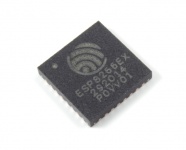Difference between revisions of "ESP8266EX"
(Created page with "ESP8266EX, single Chip WiFi network solution, SoC, 802.11bgn Smart Device ESP8266EX It's part of the radino-series, which provides full-Ard...") |
|||
| Line 1: | Line 1: | ||
ESP8266EX, single Chip WiFi network solution, SoC, 802.11bgn Smart Device | ESP8266EX, single Chip WiFi network solution, SoC, 802.11bgn Smart Device | ||
| − | [[File:ESP8266EX.jpg|x150px| | + | |
| + | [[File:ESP8266EX.jpg|x150px|left|ESP8266EX]] | ||
| + | ESP8266 is a highly integrated chip designed for the needs of a new connected world. It offers a complete and self-contained Wi-Fi networking solution, allowing it to either host the application or to offload all Wi-Fi networking functions from another application processor. | ||
| + | |||
| + | ESP8266 has powerful on-board processing and storage capabilities that allow it to be integrated with the sensors and other application specific devices through its GPIOs with minimal development up-front and minimal loading during runtime. Its high degree of on-chip integration allows for minimal external circuitry, and the entire solution, including front-end module, is designed to occupy minimal PCB area. | ||
| + | |||
| + | ''In-Circuit GmbH offers:'' | ||
| + | *Integration of ESP8266EX in your Design | ||
| + | *Review of your Design files | ||
| + | *Antenna matching | ||
| + | *Support your certification process | ||
| + | *Assemble your boards (prototypes and series production) | ||
| Line 10: | Line 21: | ||
'''Features:''' | '''Features:''' | ||
| − | |||
| − | |||
*802.11 b/g/n protocol | *802.11 b/g/n protocol | ||
*Wi-Fi Direct (P2P), soft-AP | *Wi-Fi Direct (P2P), soft-AP | ||
*Integrated TCP/IP protocol stack | *Integrated TCP/IP protocol stack | ||
*Integrated TR switch, balun, LNA, power amplifier and matching network | *Integrated TR switch, balun, LNA, power amplifier and matching network | ||
| − | *+ | + | *Integrated PLL, regulators, and power management units |
| − | * | + | *+20.5dBm output power in 802.11b mode |
| − | *Wake up and transmit packets in < | + | *Supports antenna diversity |
| − | * | + | *Power down leakage current of < 10uA |
| − | * | + | *Integrated low power 32-bit MCU |
| − | + | *SDIO 2.0, SPI, UART | |
| − | + | *STBC, 1x1 MIMO, 2x1 MIMO | |
| − | + | *A-MPDU & A-MSDU aggregation & 0.4μs guard interval | |
| + | *Wake up and transmit packets in < 22ms | ||
| + | *Standby power consumption of < 1.0mW (DTIM3) | ||
| + | *QFN32 package | ||
Revision as of 19:50, 6 February 2015
ESP8266EX, single Chip WiFi network solution, SoC, 802.11bgn Smart Device
ESP8266 is a highly integrated chip designed for the needs of a new connected world. It offers a complete and self-contained Wi-Fi networking solution, allowing it to either host the application or to offload all Wi-Fi networking functions from another application processor.
ESP8266 has powerful on-board processing and storage capabilities that allow it to be integrated with the sensors and other application specific devices through its GPIOs with minimal development up-front and minimal loading during runtime. Its high degree of on-chip integration allows for minimal external circuitry, and the entire solution, including front-end module, is designed to occupy minimal PCB area.
In-Circuit GmbH offers:
- Integration of ESP8266EX in your Design
- Review of your Design files
- Antenna matching
- Support your certification process
- Assemble your boards (prototypes and series production)
It's part of the radino-series, which provides full-Arduino-compatible wireless communication devices
in a small form factor, all pin-compatible to each other.
Features:
- 802.11 b/g/n protocol
- Wi-Fi Direct (P2P), soft-AP
- Integrated TCP/IP protocol stack
- Integrated TR switch, balun, LNA, power amplifier and matching network
- Integrated PLL, regulators, and power management units
- +20.5dBm output power in 802.11b mode
- Supports antenna diversity
- Power down leakage current of < 10uA
- Integrated low power 32-bit MCU
- SDIO 2.0, SPI, UART
- STBC, 1x1 MIMO, 2x1 MIMO
- A-MPDU & A-MSDU aggregation & 0.4μs guard interval
- Wake up and transmit packets in < 22ms
- Standby power consumption of < 1.0mW (DTIM3)
- QFN32 package
